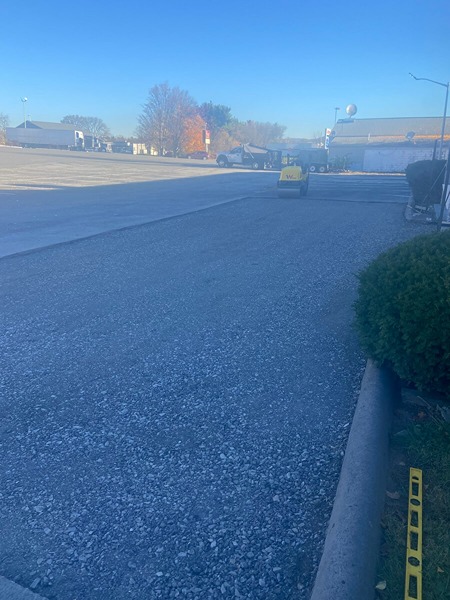Reading Asphalt: How To Identify And Evaluate Asphalt Quality
Asphalt paving contractors are responsible for ensuring the quality of asphalt and the integrity of asphalt pavements.
This article will discuss how to identify and evaluate asphalt quality. It will offer a comprehensive overview of the process, from assessing surface conditions before construction to identifying potential performance issues during and after construction.
The aim is to provide asphalt paving contractors with a clear understanding of what is required in order to ensure asphalt quality and long-term pavement performance. The article will cover topics such as pre-construction assessments, laboratory testing methods, field inspection techniques, and post-construction evaluation plans.
It will also address potential problems that can arise from poor quality asphalt or improper installation practices. By understanding these processes better, contractors can gain the knowledge necessary for producing high-performance asphalt pavements that meet customer expectations and last longer.

Pre-Construction Assessments
Asphalt is a unique construction material that is essential for modern infrastructure. It provides a strong foundation for roads, driveways, and parking lots. Understanding how to identify and evaluate asphalt quality is key to the success of any asphalt construction project.
Anecdotally, it can be said that an experienced asphalt paving contractor knows good quality asphalt when they see it. Although this experience can be very useful, there are also more scientific approaches to assessing the suitability of asphalt for use in a particular project.
Pre-construction assessments involve evaluating a range of factors including the type of aggregate used in the mix, its grading curve, its binder content, and other elements such as air voids content and permeability.
The most reliable way to assess these qualities is through laboratory testing methods which are able to provide quantifiable measurements that allow for comparison between different samples from various suppliers or from different batches of material from the same supplier. By thoroughly assessing the quality of asphalt through laboratory testing prior to construction, contractors can avoid costly mistakes and ensure their projects stand up well over time.
Laboratory Testing Methods
Asphalt quality is best identified through laboratory testing. This type of analysis helps to determine the overall composition and characteristics of each sample, as well as its suitability for a particular application.
The following laboratory testing methods can be used to evaluate asphalt samples:
– Binder Content Test: This involves taking a sample of the asphalt mix and measuring its binder content (asphalt cement) with a specific gravity test. This can help to determine whether the mix is suitable for use in road construction or other applications.
– Aggregate Testing: Another important factor in evaluating asphalt quality is the type and size of aggregate used. Aggregate testing involves measuring the size, shape, and consistency of the particles that make up the asphalt mix. The results will help to determine if it meets the necessary specifications for use in pavement construction.
– Viscosity Measurement: Viscosity tests are used to measure an asphalt’s resistance to flow. This allows contractors to better understand how an asphalt mixture will perform under different temperature conditions.
– Stability Tests: Stability tests are used to measure an asphalt’s ability to resist deformation under load, such as traffic and environmental conditions. This helps contractors assess the durability of an asphalt mix over time.
– Temperature Tests: Temperature tests measure how an asphalt reacts when exposed to extreme heat or cold temperatures. These tests are important for understanding how an asphalt mix will perform in different climates and weather conditions.
By using these laboratory testing methods, paving contractors can accurately identify and evaluate their chosen asphalt mixes for any given project or application before proceeding with their work. With this knowledge, they can ensure that their projects last longer and remain structurally sound over time.
Understanding field inspection techniques is also essential for paving success; this information will be discussed in the next section.
Field Inspection Techniques
The theory of ‘reading asphalt’ suggests that the quality of an asphalt layer can be determined by visual inspection. While there is much debate surrounding this idea, field inspection techniques can help to provide a better understanding of the condition of an asphalt layer.
Asphalt paving contractors should be aware of these techniques in order to identify and evaluate the quality of their work. One common method used to assess the strength and integrity of an asphalt layer is core sampling. This involves taking a sample from the pavement surface and examining it under a microscope or other magnifying device for any indication of weaknesses or defects such as cracks, air voids, or water saturation.
Additionally, measuring equipment such as shear testers, binder testers, and volumetric testing devices can be used to determine the properties of materials within the asphalt mix. Other field inspection techniques include visual observation for signs of distress such as surface cracking, raveling, potholes, and rutting.
These observations can provide valuable insight into the performance characteristics of an asphalt layer and allow contractors to make informed decisions about repairs or maintenance that may be needed. The next section will discuss post-construction evaluation plans which are essential for assessing both immediate performance and long-term durability.
By transitioning from field inspections to post-construction evaluations, paving contractors will have a comprehensive overview of their project’s overall condition.

Post-Construction Evaluation Plans
Once asphalt paving is completed, it is essential to evaluate its quality and performance. A post-construction evaluation plan should be developed to provide a systematic approach for assessing the condition of the asphalt. This plan should include regular visual inspections and measurements of the pavement surface texture, density, and structural integrity. Such evaluations can help identify any potential construction deficiencies that may need to be addressed before they result in further damage or costly repairs.
Inspection frequency varies depending on the type of pavement and traffic load, but generally should occur every three to six months initially and then annually thereafter. During an inspection, contractors should check the surface condition of the pavement for rutting, raveling, cracking, blockiness, flushing/bleeding, puddling/pooling, shoving/shoving cracks, joint failure and other distress types that could indicate decreased performance.
Additionally, contractors should also measure areas such as ride quality (IRI), texture depth (SDMT) and skid resistance (SRT). The data collected from these evaluations can then be used to develop a comprehensive maintenance program for addressing any existing or potential issues related to performance.
This proactive approach helps ensure that asphalt pavements remain in optimal condition throughout their service life. By taking advantage of post-construction evaluation plans, contractors can significantly reduce long-term costs and maximize pavement longevity. From here we will look at how to identify potential performance issues with asphalt pavements.
Identifying Potential Performance Issues
Asphalt paving contractors need to be able to identify potential performance issues that may arise when working with asphalt. The most common performance issues identified are cracking, rutting, and bleeding.
Cracking occurs when the asphalt becomes brittle due to age or inadequate compaction of the material. Rutting is caused by poor surface drainage or use of a substandard material. Bleeding occurs when bitumen seeps out from between the aggregate particles which causes a sticky film on the surface of the pavement.
In order to evaluate an asphalt’s performance potential, it is important for contractors to consider several factors:
-The type and grade of material used for the job
-The soil conditions in which it will be laid
-The compaction techniques used during installation
-The environment in which it will be exposed
By evaluating these factors, asphalt paving contractors can better understand the performance potential of their project and take steps to avoid any potential issues that may arise. Additionally, regular maintenance and inspections can help ensure that any existing problems are quickly identified and addressed before they become more serious.
Conclusion
Asphalt is an essential part of any paving project, and it’s important to ensure its quality.
The best way to identify and evaluate asphalt quality is through a combination of pre-construction assessment and post-construction evaluation plans.
Tests should be conducted to measure the strength, durability and flexibility of the asphalt.
Regular maintenance is also key in order to maintain a high level of performance over time.
By following these steps, asphalt paving contractors can guarantee a successful long-term result for each and every project.
Asphalt paving contractors must remain vigilant in their efforts to ensure the highest quality product for their clients.
Quality control measures that are taken before, during, and after construction will go a long way towards ensuring the longevity and success of any asphalt paving job.
With careful planning, attention to detail, and ongoing maintenance, asphalt can be relied upon for years of reliable service.
What Should I Do If I Suspect My Asphalt Is Of Poor Quality?
Just as a ship’s captain must identify and assess the risks of an impending storm before it arrives, so too must a paving contractor take steps to identify and evaluate asphalt quality before it is installed.
A thorough evaluation should include visual inspections of the asphalt, testing for proper compaction, and testing for presence of contaminants.
In addition, any existing pavement base should be analyzed for strength and stability.
Taking all these actions can ensure that the quality of the asphalt will not become an issue later on.
What Is The Difference Between A Pre-Construction Assessment And A Post-Construction Evaluation Plan?
A post-construction evaluation plan is done after the asphalt has been laid to assess its quality and suitability.
The evaluation plan will help identify any potential issues with the asphalt paving that may need to be addressed in order to ensure the longevity and durability of the surface.
How Can I Determine If My Asphalt Will Perform Well Over Time?
To do this, they must assess the quality of the material and create a plan to monitor any potential issues.
This can be done through a pre-construction assessment that examines the aggregate size, gradation, and binder content; as well as a post-construction evaluation plan that monitors pavement performance.
By considering these factors in tandem, asphalt paving contractors can make sure their product will remain durable and reliable.
What Types Of Tests Should I Consider To Evaluate Asphalt Quality?
Asphalt paving contractors must also ensure that the asphalt mix design meets the specifications of the job. Finally, it is important to conduct field acceptance testing on newly constructed pavements to ensure that they meet performance requirements.
What Kind Of Maintenance Is Needed To Keep Asphalt In Good Condition?
The most effective maintenance method is sealcoating, which involves applying a protective layer of asphalt emulsion or coal tar over the surface of the pavement. This helps protect the asphalt from UV radiation, water damage, and other environmental factors.
Crack sealing is also recommended on a regular basis to fill any existing cracks and prevent further damage to the asphalt.
Other maintenance tasks include patching holes, removing vegetation, filling potholes, and sweeping away debris.
All of these activities should be performed regularly in order to ensure that your asphalt remains in good condition for as long as possible.